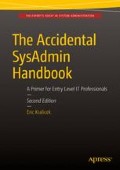Abstract
DNS is one of the three main pillars supporting domain services (DNS, Kerberos, and LDAP). Inside the local network, DNS acts to translate IP addresses into hostnames and vice versa. Fundamental to the Internet, DNS also translates domain names into IP addresses. There is a long history of DNS-related RFCs that document the many changes and adaptions DNS has undergone since its conception. Current DNS supports both IPv4 and IPv6. Basically, DNS is a network of databases established to resolve IP addresses and spans the world supporting all Internet traffic.
Access this chapter
Tax calculation will be finalised at checkout
Purchases are for personal use only
Notes
- 1.
- 2.
- 3.
- 4.
- 5.
http://enterprise.alcatel-lucent.com/?product=VitalQIP&page=features
- 6.
- 7.
- 8.
- 9.
- 10.
In computers, an octet (from the Latin octo or “eight”) is a sequence of eight bits. An octet is thus an eight-bit byte. Since a byte is not eight bits in all computer systems, octet provides a non-ambiguous term.
- 11.
Supernetting, also called Classless Inter-Domain Routing (CIDR), is a way to aggregate multiple Internet addresses of the same class. The original Internet Protocol (IP) defines IP addresses in four major classes of address structure, Classes A through D. Each class allocates one portion of the 32-bit Internet address format to a network address and the remaining portion to the specific host machines in the network. Using supernetting, the network address 192.168.2.0/24 and an adjacent address 192.168.3.0/24 can be merged into 192.168.2.0/23. The 23 at the end of the address says that the first 23 bits are the network part of the address, leaving the remaining nine bits for specific host addresses. Supernetting is most often used to combine Class C network addresses and is the basis for most routing protocols currently used on the Internet.
- 12.
- 13.
Penny Hermann-Seton GIAC GSEC Practical Assignment b1.4 – SANS Institute 2002: http://www.sans.org/reading_room/whitepapers/protocols/security-features-ipv6_380
- 14.
Steve Friedl’s Unixwiz.net tech tip: http://unixwiz.net/techtips/iguide-ipsec.html
- 15.
The first RFC for IPv6: http://tools.ietf.org/html/rfc1883
- 16.
Address syntax: http://tools.ietf.org/html/rfc3513
- 17.
Automatic private internet protocol addressing: http://msdn.microsoft.com/en-us/library/aa505918.aspx
- 18.
- 19.
Author information
Authors and Affiliations
Rights and permissions
Copyright information
© 2016 Eric Kralicek
About this chapter
Cite this chapter
Kralicek, E. (2016). DNS, DHCP, IPv4, and IPv6. In: The Accidental SysAdmin Handbook. Apress, Berkeley, CA. https://doi.org/10.1007/978-1-4842-1817-4_11
Download citation
DOI: https://doi.org/10.1007/978-1-4842-1817-4_11
Publisher Name: Apress, Berkeley, CA
Print ISBN: 978-1-4842-1816-7
Online ISBN: 978-1-4842-1817-4
eBook Packages: Professional and Applied ComputingProfessional and Applied Computing (R0)Apress Access Books

